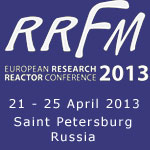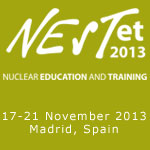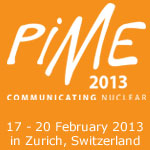

ENC2012: A Romanian Young Generation report on ENC 2012
The European Nuclear Conference (ENC) 2012 took place in Manchester, United Kingdom, from 9 – 12 December 2012. It was organised by the European Nuclear Society (ENS) in cooperation with a number of partners and attracted hundreds of professionals from about 40 countries to the Manchester Central Convention Complex, in the city’s historic Central Railway Station.
The topics that were covered included nuclear power and non-power applications and featured highly technical papers that addressed social and political questions within the post-Fukushima environment.
The social programme kicked off on Sunday, 9 December, with the Welcome Reception and conference pre-registration at Manchester Town Hall.

Experts from different fields, such as the research community, academia, governments, industry and other nuclear organisations, presented their views and discussed different topics related to the nuclear field. In addition to the registered participants, the high technical level of attendance at ENC 2012 was further supported by the participation of experts and senior managers from industrial companies such as General Electric, Westinghouse, Hitachi, AREVA, EDF, ROSATOM, Urenco, Iberdrola, Ansaldo Nucleare, Rolls Royce, etc.
The Opening Session of the conference on the morning of Monday 10 December was held in the Auditorium. It was chaired by Norman Harrison, President of the Nuclear Institute and co-chaired by Marco Streit, ENS President. It included the participation of several eminent people who delivered keynote speeches, including the Lord Mayor of Manchester.
During the Plenary Session entitled New Build a summary of the post-Fukushima European nuclear scenario was presented. The Plenary Session entitled Life Science and other Applications highlighted some of the varied applications of nuclear technology in the field of medicine (including diagnosis and epidemiology), space exploration, etc. The opening day concluded with a series of parallel sessions devoted to the following topics: New Build, Fuel Cycle, Plant Operations, Research Reactors and the Young Generation ENS-YG workshop entitled Building Bridges between Generations.
The social programme included the Conference Dinner, which was hosted in a unique location - one of Manchester’s most significant buildings, Manchester Cathedral. It was a great opportunity for participants to socialise and exchange thoughts and opinions about various nuclear and non-nuclear subjects.
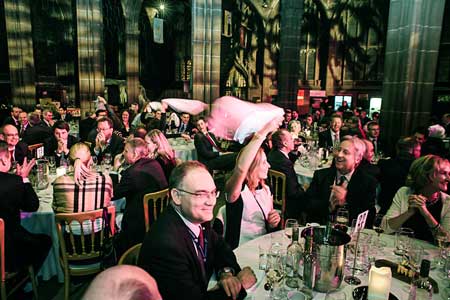
The second day of the event, Tuesday 12 December, started with a series of parallel sessions that introduced various interesting subjects, such as New Build, Plant Operations, End of use: Treatment/Remediation, Education and Training and Simulation & Generation III.
The Plenary Session entitled Fuel Cycle was chaired by Jean-Pol Poncelet, Director General of FORATOM, and co-chaired by Marco Streit, ENS President. It benefited from the contribution of top companies: Paul Harding, Urenco’s UK representative, presented a news update on the latest uranium enrichment technology and laid down a challenge to participants to consider and debate the possibility of replacing Uranium fuel with Thorium; Leo Shannen, from the Belgium Nuclear Materials Science Institute, summarised 50 years of Nuclear Fuel Qualification at SCK.CEN. In his presentation he also highlighted some concerns linked to proliferation; Marco Streit, from the Paul Sherrer Institute in Switzerland, presented developments in advanced fuel technologies and innovative small reactors research, as well as the innovative concept of fully closing the fuel cycle; Dominique Warin, of the CEA (France’s Atomic Energy and Alternative Energy Commission), shared with delegates the challenges posed by studies that the CEA is carrying out into minor-actinide bearing fuel options.
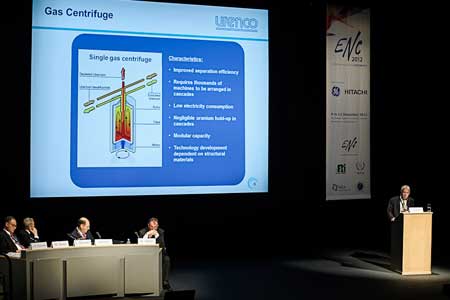
The day continued with a posters session, where specialists from different domains presented a summary of their work in a few slides and pictures. The titles of the poster sessions were: Education, Training and Knowledge Management, Plant Operations, New Build, Fuel Cycle, Life Science Application, Nuclear in the Civil Society, Non-power Industrial Applications, Reactor Technologies and End of Use.
Parallel sessions also took place on the second day of the conference. During the New Build session, A. Bugat from NucAdvisor, France, presented some ideas about how the IAEA’s Milestones Process can be reshaped taking into account the new post-Fukushima context and the fact that newcomers have arrived on the industrial scene. Also, he challenged the audience to think about what the real drivers of a nuclear project are today.
Olivier Rousselot, of EDF, the Manager of the EUR Revision D Project, summarised the goals and achievements of the licensing process for LWRs that have been licensed for 60 years. Even if the document he presented is not a regulatory document, it includes all safety principles, integrates all WENRA levels and fully considers both the lessons learned from Fukushima and the results of the stress tests. This will be of great help to newcomers in nuclear - and also to others who are less new.
The WNA’s Director of Licensing, Christian Raetzke, spoke about the licensing risks associated new nuclear build, as revealed by an industrial survey that focused on the interaction of the regulatory processes with the other processes involved (procurement, safety, etc.). There is no one-size-fits-all licensing model because of the very diverse regulatory frameworks and political and economic environments that exist in different countries. This is why the process varies not only from country to country, but also within the same country. When facing a FOAK (first-of-a kind) or a FIAC (first-in-a-country) scenario, where the licensing process can be approached differently, either in a one step or multi-step way, pre-licensing can be considered. When dealing with a NOAK (nth-of-a-kind), standardisation can facilitate the process.
Lydie Sartout, speaking on behalf of the french nuclear industry, presented the French approach to supporting a nuclear new build project abroad, stressing adaptability and flexibility and the life cycle of a nuclear project - whatever the individual country’s framework might be. She also noted some of the characteristics of the UK’s EPR Generic Design Assessment Project, which is an EDF and AREVA joint application project.
EDF’s Deputy Director of Planning and External Affairs, Stephen Walls, underlined some of the important milestones that have been reached with regards to future nuclear new build, as well as the key issues and the next steps facing it, including market structure, planning permits, licensing, waste disposals and investment decisions.
The final day of the conference began with parallel sessions and with a World Nuclear Transport Institute (WNTI) workshop entitled Transport of nuclear fuel cycle – Getting it where it is needed. This workshop featured representatives of International Nuclear Services, Westinghouse UAM and AREVA’s Business Logistics Unit. Other parallel sessions included the Women in Nuclear (WiN) Europe workshop entitled Nuclear Installation safety-research laboratories and raddioisotope production facilities: lessons learned from Fukushima, which was chaired by Anne-Marie Birac, of WiN Europe.
The Plenary Session Issues & Challenges for the Future of Nuclear took place in the Auditorium and featured the following presentations: The system cost of different power generation technologies: A New Look at the Competitiveness of Nuclear Power, The organisation of energy markets and nuclear opportunities, Nuclear Technologies for the future: Gen IV and Education, Training and Knowledge Management.
ENC 2012 was officially closed by the ENS President, Marco Streit, and the ENS Honorary President, Frank Deconinck. A concluding conference statement was made by Eileen Radde, of the Austrian Nuclear Society.
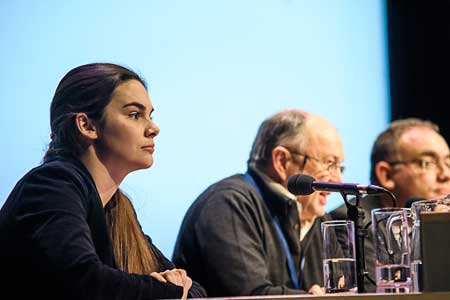
ENC2012 also hosted an exhibition, in which different companies presented their profiles and promoted their capabilities within the industry. This was another opportunity for participants to discuss, exchange views and share experiences.
The last event of the year, ENC2012 addressed and condensed a wide range of subjects. Participants looked back into history to identify the lessons that have been learned from various events and case studies. They also received an update on the current nuclear power and technology scenario. It was a step back that enabled them to look into the future. They were invited to imagine how visionary and challenging ideas today might one day be brought to life.
Elena Sima
Safety and Licensing Department
AMEC
Young Generation Romania |


